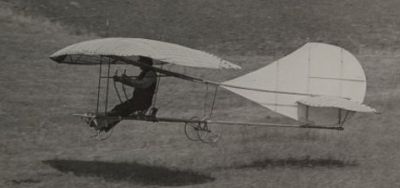The Wright Brothers have long received the credit for being the ones to invent the airplane and be the first in flight. According to a book published in 2012, and seeing a resurgence with the 115th anniversary of the Wright Brothers flight, this is incorrect.
According to authors Craig S. Harwood and Gary Bryce Fogel, the first person to fly a plane took place in 1883 by a Californian scientist named John J. Montgomery, who piloted a plane 20 years before the Wright Brothers at Kitty Hawk in 1903.
John Joseph Montgomery was born on Feb. 15, 1858. He was an American inventor, physicist, engineer, and professor at Santa Clara University who is best known for his invention of controlled heavier-than-air flying machines.
Montgomery began creating aircrafts in the 1880s. In the years 1883 to 1885, he created four different plane designs: one was a flapping monoplane, the second was a curved wing glider, the next one featured hinged surfaces at the rear of the wings to maintain lateral balance, and last was for the two wings to be flying at the same time to maintain lateral balance.
According to SouthBayCompass.com, “In Otay Mesa, a monument commemorates the first heavier-than-air flight ever taken on this very hill.
The inscription reads: “John J. Montgomery made man’s first controlled winged flight from this hilltop in August 1883. He opened for all mankind the great highway of the sky.” Montgomery chose the Otay Mesa, near San Diego, for its favorable topographic features as well as its seclusion from onlookers, as he did not want his attempts publicized Park neighborhood, according to the Glen Park History Project.
According to the Glen Park History Project website, “Maloney described his 20-minute experience as the first man to fly fixed-wing at such an altitude: ‘… as I looked at the ground so far below me and realized I was sailing on a machine that weighed only 42 pounds … I was able to steer and turn and go up and down and I think I felt just about like a bird feels …’”
On July 18, 1905 tragedy struck, the website reports. “As Maloney sat astride the Santa Clara, Professor Montgomery noticed a balloon handling line had become entangled around one of the glider’s wing struts during liftoff. He called out to Maloney to just ride the balloon back down, but he was beyond earshot. At about 3,000 feet, the suspension until he neared perfection. The flights culminated in 1905 with controlled flights in Northern California using tandem-wings, Montgomery’s gliders were launched from balloons reaching altitudes that at the time were immeasurable. His design and research showed that aerial navigation was not impossible. Flyingmachines.com backs up the evidence that Montgomery was the first to pilot a flying monoplane. Also, it notes that in 1884 he constructed the monoplane which is 19 years before the Wright Brothers at Kitty Hawk in 1903. He was the pioneer of flight and the engineering program at Santa Clara University was named after him.
The pilot of that flight in Santa Clara was 21-year-old Daniel John Maloney, a first generation Irish-American, who lived in San Francisco’s Glen rope was cut and the glider was on its own. It soon became uncontrollable, dipping, swerving, and overturning several times. . . . Maloney worked desperately to maintain control, then clung to the machine as it plunged to the ground in front of 2,000 horrified spectators at Santa Clara College. Tragically, he was killed on impact.”
Montgomery died on Oct. 31, 1911, eight years after the Wright Brothers’ flight at Kitty Hawk, also in an aircraft crash. The accident happened at Evergreen, a camp in the foothills five miles south of San Jose. Less than 20 feet in the air, the craft stalled, flipped over, and landed upside down. Montgomery survived for a brief moment, asking, “How is the machine?” He is buried at Holy Cross Catholic Cemetery in Colma









